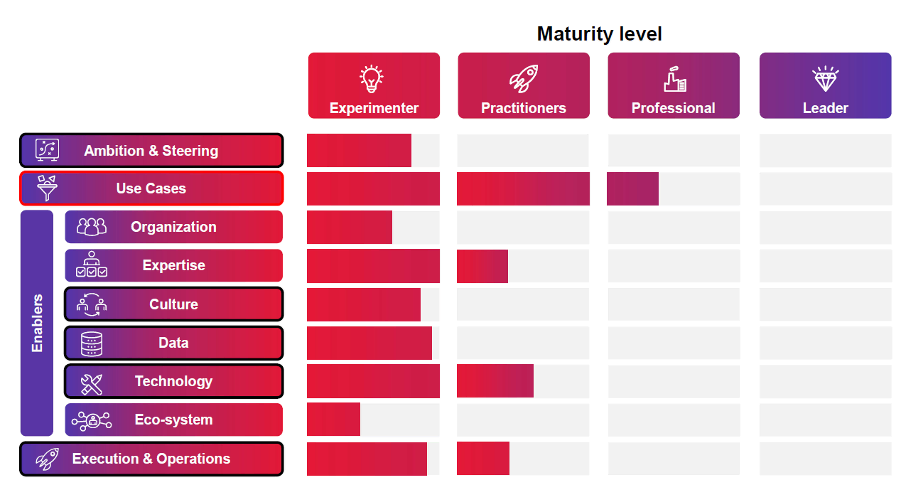The starting shot has long since been fired and it is high time to pick up speed so as not to miss the boat. But speed alone is not enough. In order to use artificial intelligence (AI) sensibly as a value-adding technology, a clearly structured, methodical approach is required so that it does not become an expensive disappointment. Four “E’s” provide the right orientation for this.
The hype surrounding artificial intelligence, especially generative AI, has a gold-rush feel to it. In a situation like this, it is advisable to stay cool, soberly analyze the opportunities and risks for your own company and draw the right conclusions. This removes a large part of the breeding ground for misjudgements, undesirable developments and disappointments.
CGI has developed a framework that describes and links the four most important steps on the path to becoming an AI-driven company. They are the imperatives for practical action across all four phases of the AI lifecycle and thus help to make meaningful and successful use of the innovative power of artificial intelligence.
1. Envision: designing the AI vision
It all starts with the idea, the big picture. It must be ensured from the outset that the AI strategy contributes to the overarching corporate goals and is not seen as a value in itself. Whatever the specific AI strategy then looks like, its success depends largely on a company’s level of maturity. Ambitious AI projects make little sense if the company is not yet ready for them in many areas. This applies to the planning and management level as well as the operational departments and the potential application scenarios (use cases) for AI.
The current maturity level of a company is determined by taking a detailed inventory of the status quo. Important criteria for this are the organizational structure, existing expertise, corporate culture, data availability, technical and personnel requirements and, last but not least, the surrounding ecosystem. It is also important to identify which departments have already implemented AI systems and to take an inventory of these if necessary. Based on this analysis, a roadmap can then be formulated and risk and compliance management for the safe and responsible use of AI can be implemented.

2. Experiment: Exploring the potential of AI
While the first step was to think big (big bang approach), the start of practical implementation is exactly the opposite. One of the most common mistakes is to want to become an AI-driven company overnight. The pressure to change is too great, the risk of change is incalculable, the necessary investments are immense and the added value, if it is achieved at all, is only visible much later. A methodically sensible approach, on the other hand, relies on identifying manageable use cases and developing corresponding proof-of-concepts (PoC) for them.
Ideally, the use cases are located in non-productive environments and successes are quickly visible, which reduces the risks of failure and increases transparency. In this phase, it is important to meticulously analyze and document progress and setbacks.
Based on this experience, a shortlist can then be created that prioritizes the use cases with the greatest potential. This then forms a kind of practically tested pipeline for the subsequent development of specific AI applications. In the PoC phase, the insufficient database for training and evaluating AI models often turns out to be a problem. This concerns both the quantity and the quality of the available data. It therefore makes sense to use appropriate data platforms, whereby the question of whether they provide the data in a centralized or decentralized manner is of secondary importance. The decisive factor is availability.
3. Engineer: Developing the basics of AI
Now it’s getting serious: the PoC-tested AI roadmap is available, now it’s time to implement it and develop AI applications for operational use. To this end, the AI models are trained with productive data and architectures, platforms, standards, technologies and parameters are optimized until they are ready for use in specific business processes. We are therefore in an iterative process of constant adaptation and approximation to the practical use of AI. At a technical level, this means consolidating and quality assuring data and expanding the AI and data infrastructure, among other things.
This is also the time to get potential users on board. Ideally, this should take place on two levels: Firstly, as a change management process initiated and controlled by the management level, and secondly in the practical form of education and training programs to increase AI competence. After all, whether an AI application actually has the desired effects depends not least on the employees who are to use it.
Change managers often have to deal with irrational fears such as the “Hollywood” phenomenon. In many films of the eighties and nineties, AI was stylized as a villain. These images have become ingrained. If AI is to be used sensibly, i.e. to create value in the best sense, it must be demystified. It is also important to prevent AI projects from being driven forward in an uncoordinated manner at various points in the company. A sensible AI strategy therefore envisages the establishment of an internal Center of Excellence (CoE). It coordinates and supports the AI processes, documents them and identifies synergies without “interfering” with the departments.
4. Expand: Expanding the AI capabilities
This is a start, but the true value of AI-supported processes will only be realized if they are constantly expanded, refined and implemented in more and more use cases. To this end, it is necessary to introduce AI ops in the departments in order to prevent operational risks of AI systems, promote continuous quality assurance and enable seamless scaling at high capacity utilization. This creates an AI ecosystem that is highly valuable for further development. The Center of Excellence also plays a key role here. As a counterpart to this operational level, the use of AI must be accompanied by appropriate standards and regulations. This includes lifecycle governance that formulates guidelines for each step in the lifecycle of an AI application and defines the processes, safety regulations and responsibilities.
Conclusion
To avoid any misunderstanding, these four “E’s” are not a recipe for guaranteed success. The meaningful and value-adding use of AI always has to do with people and therefore, in addition to a structured approach, qualities such as empathy, error management and motivation are also required to make it a successful model.




